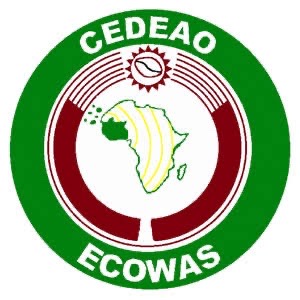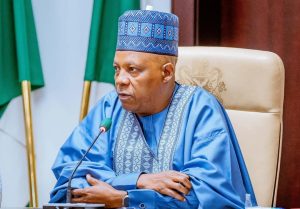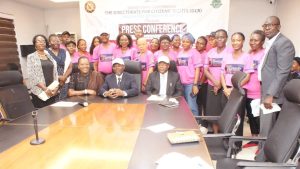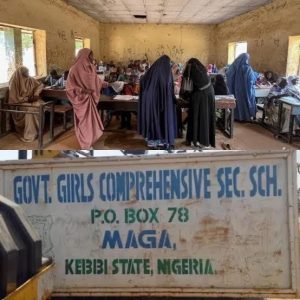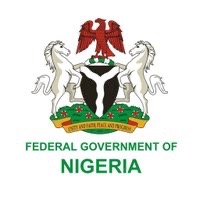As the world celebrates Menstrual Hygiene Day, which is a day set aside to educate people on the need to prioritize cleanliness during menstruation, NalaFem, an Organization of activists who advocate for gender equality yesterday drew the attention of Africa to the challenges her young girls and women face as a result of taxation placed on menstrual products.

For the importance of this topic to the health of African women, young and old, and the fact that I am a young African woman who is faced with the same challenges, as well as the demand of the esteemed fans and readers of the Whole Society column that this week’s discourse be centered on menstrual hygiene to educate more people on the need to create an environment that will help women keep clean during menstruation, I find it worthy that I abandoned the topic I was prepared to write on, to be able to lend my voice to the growing calls for support for women’s access to qualitative reproductive health like their counterparts in other continents.
Sexual and reproductive health rights is one among the manifesto cum demands of NalaFem. As a result, it is important to have a proper understanding of what sexual and reproductive health rights entails, and why NalaFem frowns at taxation of menstrual products in Africa.
The year 2019 marks two important milestones in the field of reproductive health: 50 years since UNFPA began operations, and 25 years since the landmark International Conference on Population and Development (ICPD) in Cairo.
These two events—the launch of the first United Nations agency dedicated to addressing population growth and the reproductive health needs of the world’s people, and the declaration of a global commitment to sexual and reproductive health and reproductive rights—have fundamentally shaped the lives of women and families, and the societies in which they live, in ways measurable and immeasurable, profound and trivial, permanent and fleeting. Activists, advocates, public health specialists and many others have pushed relentlessly for the transformations we see around us today, but much remains to be done. What the future holds in terms of changes in population growth, contraceptive use and sexual and reproductive health and rights will both determine and be determined by the ability of women and girls to achieve their full potential as members of their societies. And this will be determined, in no small part, by how the world takes forward the achievements and addresses the shortfalls of the ICPD to date.
The world in 1969:
Fifty years ago around the world, the average woman had 4.9 children, and 35 per cent of married women were using some form of contraceptive method to delay or prevent pregnancy; in the least developed countries, however, the average woman had 6.7 children, and about 2 per cent were using a method of contraception. Abortion was illegal in much of the world, and the women’s liberation movement was fighting for equality in access to education, employment opportunities and pay, marriage and divorce, property ownership, and on a range of other fronts. In 1969, the Stonewall Riots in New York
City marked the start of the global gay rights movement; the United States Agency for International Development established an Office of Population; and Ghana adopted its policy for Population Planning for National Progress and Prosperity. A year earlier, at the first United Nations International Conference on Human Rights, in Tehran, delegates had affirmed, for the first time in a global declaration, the basic right of parents “to determine freely and responsibly the number and the spacing of their children” (United Nations, 1968).
By 1969, as a result of public health interventions that were reducing infant and child mortality and prolonging life expectancy, birth rates had outstripped mortality rates in much of the developing world. Concerns that the resulting population growth could harm economic progress and the environment contributed to the desire to better understand and manage human fertility. The establishment of the United Nations Fund for Population Activities, renamed the United Nations Population Fund in 1987, reflected a growing interest in understanding how population dynamics affected social and economic development, and a desire on the part of the United Nations to support action programmes aimed at stabilizing the world’s population. The expanding availability of relatively new and effective contraceptive methods during the 1960s was transformational for women, offering them, for the first time, the ability to reliably prevent unintended pregnancy and new choices in controlling their reproductive lives.
But the implications of contraception and fertility regulation for the health, well-being and economic and social lives of individual women and girls were only beginning to be understood. A fuller realization of what they would mean was still to come.
The world in 1994
Twenty-five years ago, when the ICPD was held in Cairo, the average global fertility rate was about three births per woman, and 58.8 percent of women worldwide were using contraception; in the least developed countries, fertility was about 5.6 children, and 20.2 percent of married women were using contraception. South Africa held its first multiracial elections and elected Nelson Mandela as President; the Rwandan genocide resulted in the deaths of more than 800,000 men, women, and children; civil unions between same-sex partners were legalized in Sweden; and the launch of America Online, or AOL, marked the beginning of easy access to the Internet. The years preceding the ICPD saw a gradual and accelerating shift: from a primary focus on population issues and fertility reduction to one grounded in the rights of individuals and couples to prevent or delay pregnancy and attain sexual and reproductive health. This shift was largely driven by feminists and advocates for sexual and reproductive health and rights, and was, in part, a response to the abuses that resulted from target-driven “population control” policies of the past. In the 1970s and 1980s, with funding and encouragement from wealthy donor countries and foundations, some countries had rolled out programmes that coerced or forced couples to use contraception or limit their family size, or provided monetary or other incentives to convince them to do so.
The ICPD Programme of Action adopted by 179 governments called explicitly for dropping demographic and fertility-control targets from national population and family planning programmes. While still acknowledging that population dynamics merited consideration in policymaking, the Programme of Action issued a clarion call to place women’s needs and rights at the centre of population and development policies. What the world needed, governments agreed, was to provide women, couples and families with access to a range of sexual and reproductive health interventions, and to realize social and economic changes that would empower women, respect their rights, and help move the world towards gender equality. Advances and setbacks since 1994 The ICPD consensus was a turning point, and a transformative victory for the reproductive rights movement. By placing individual rights and well-being at the centre of the reproductive health agenda, it set in motion a number of shifts: in research, to explore the factors that influence individual choices and behaviour in relation to contraceptive use or non-use and fertility; in communication, to inform and educate women, men and decision makers about the health, economic and social benefits of reducing fertility and preventing unintended pregnancies; and in service delivery, to underscore the importance of providing a full range of contraceptive methods and ensuring choices for all women.
A new paradigm: 2015 and the Sustainable Development Goals
In September 2015, 193 governments adopted a new global framework to succeed the MDGs. Unlike the MDGs, the SDGs explicitly recognize sexual and reproductive health as essential to equitable development and women’s empowerment, referencing sexual and reproductive health under SDG 3, for health, and again under SDG 5, for gender equality, which also references reproductive rights. As was the case with the ICPD and the MDGs, however, the SDGs do not acknowledge sexual rights. Other central elements of sexual and reproductive health, including maternal and newborn mortality and HIV, were addressed under targets for SDG 3, and gender-based violence and harmful practices under targets for SDG 5.
2019 and beyond
UNFPA’s 50th anniversary and ICPD’s 25th anniversary present a unique opportunity for the global community to build on the ICPD framework and fully commit to realizing a visionary agenda for sexual and reproductive health and rights, and to reaching those who have been left behind. This agenda must pay attention to population dynamics, recognize the diverse challenges faced by different countries at various stages of development, and ground policies and programmes in respect for, and fulfilment of, human rights and the dignity of the individual.
There is enormous momentum around efforts to achieve the SDGs, including a renewed commitment to “health for all,” explicitly recognizing that every human being has a fundamental right to the enjoyment of the highest attainable standard of health, without distinction. The Every Woman Every Child movement, launched by former United Nations Secretary-General Ban Ki-moon in 2010 and now led by Secretary-general António Guterres, brings concerted attention and effort to the SDGs and universal health coverage as they relate to women, girls and adolescents, with sexual and reproductive health and rights as one of its key focus areas. The pursuit of rights and choices for all is an ongoing one, with new challenges emerging all the time. Over the years, the nature and scope of these obstacles may have changed, but the international community’s commitment to overcoming those remains strong.
So, having gone through the above and have gotten a proper understanding of the demand, you’d agree with me reproductive health rights advocate for the availability of products that enhances sexual and reproductive health care system, hence, Menstrual products as well.
It is quite appalling to know that, these basic crucial necessities that young men and women need in Africa are overtly becoming high due to the excess tax placed them. This has been an issue of concern for NALAFEM, and today, being 28th of May, 2021, which is the day to celebrate Menstrual Hygiene day, a webinar to discuss this issue of taxation of menstrual products in Africa.
The webinar which was convened by Amina S via zoom, was aimed at tackling certain issues that bother on taxation of menstrual products in Africa.
The webinar comes to join further activities taking place on the African continent to think deeply about the issues that underpin the access to Menstrual Hygiene day on May 28th.
In the conversation, particular focus was on concrete steps to push for change. These are solutions that have been designed with young women, and not without them. The conversation was not hypothetical. As activists, on the ground, we are advocating for the removal of taxation on menstrual products, and enforcement of progressive period policies in all workplaces and the provision of free sanitary pads and sanitation in all schools.
This is in alignment with our mission of ensuring the demands of Africa Young Women Beijing+25 Manifesto are mainstreamed at intergovernmental and grassroots level. With Generation Equality Forum being around the corner, and in consideration of the Action Coalition commitment on Bodily Autonomy and Sexual and Reproductive Health and Rights, the conversation was aimed at explaining why the time is now to discuss period poverty and provide solutions, accordingly.
In fact, it is believed that, it is unacceptable in 2021 to have girls drop out of school or lose their jobs because of their periods. Conversations on Menstrual Hygiene matter, and we implore all and sundry to help we push for our demands.
Our demand is for every country to have a structural policy on the removal of taxation on menstrual products. And it is high time African countries move towards the building of menstrual health hygiene coalition
We demand for tax-free menstrual products.
Happy world’s menstrual Hygiene day, 2021.












